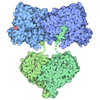+ Open data
Open data
- Basic information
Basic information
| Entry | Database: PDB / ID: 5h1c | |||||||||||||||||||||
|---|---|---|---|---|---|---|---|---|---|---|---|---|---|---|---|---|---|---|---|---|---|---|
| Title | Human RAD51 post-synaptic complexes | |||||||||||||||||||||
 Components Components |
| |||||||||||||||||||||
 Keywords Keywords | DNA BINDING PROTEIN/DNA /  DNA repair / DNA repair /  ATPase / ATPase /  homologous recombination / DNA BINDING PROTEIN-DNA complex homologous recombination / DNA BINDING PROTEIN-DNA complex | |||||||||||||||||||||
| Function / homology |  Function and homology information Function and homology informationpresynaptic intermediate filament cytoskeleton / mitotic recombination-dependent replication fork processing / chromosome organization involved in meiotic cell cycle / cellular response to camptothecin / DNA recombinase assembly / telomere maintenance via telomere lengthening / positive regulation of DNA ligation /  mitotic recombination / double-strand break repair involved in meiotic recombination / nuclear ubiquitin ligase complex ...presynaptic intermediate filament cytoskeleton / mitotic recombination-dependent replication fork processing / chromosome organization involved in meiotic cell cycle / cellular response to camptothecin / DNA recombinase assembly / telomere maintenance via telomere lengthening / positive regulation of DNA ligation / mitotic recombination / double-strand break repair involved in meiotic recombination / nuclear ubiquitin ligase complex ...presynaptic intermediate filament cytoskeleton / mitotic recombination-dependent replication fork processing / chromosome organization involved in meiotic cell cycle / cellular response to camptothecin / DNA recombinase assembly / telomere maintenance via telomere lengthening / positive regulation of DNA ligation /  mitotic recombination / double-strand break repair involved in meiotic recombination / nuclear ubiquitin ligase complex / DNA strand invasion / replication-born double-strand break repair via sister chromatid exchange / cellular response to hydroxyurea / DNA strand exchange activity / lateral element / telomere maintenance via recombination / mitotic recombination / double-strand break repair involved in meiotic recombination / nuclear ubiquitin ligase complex / DNA strand invasion / replication-born double-strand break repair via sister chromatid exchange / cellular response to hydroxyurea / DNA strand exchange activity / lateral element / telomere maintenance via recombination /  regulation of DNA damage checkpoint / Impaired BRCA2 binding to PALB2 / single-stranded DNA helicase activity / reciprocal meiotic recombination / Defective homologous recombination repair (HRR) due to BRCA1 loss of function / Defective HDR through Homologous Recombination Repair (HRR) due to PALB2 loss of BRCA1 binding function / Defective HDR through Homologous Recombination Repair (HRR) due to PALB2 loss of BRCA2/RAD51/RAD51C binding function / Homologous DNA Pairing and Strand Exchange / Resolution of D-loop Structures through Synthesis-Dependent Strand Annealing (SDSA) / Resolution of D-loop Structures through Holliday Junction Intermediates / HDR through Single Strand Annealing (SSA) / Impaired BRCA2 binding to RAD51 / ATP-dependent DNA damage sensor activity / regulation of double-strand break repair via homologous recombination / nuclear chromosome / replication fork processing / DNA unwinding involved in DNA replication / Transcriptional Regulation by E2F6 / Presynaptic phase of homologous DNA pairing and strand exchange / ATP-dependent activity, acting on DNA / interstrand cross-link repair / regulation of DNA damage checkpoint / Impaired BRCA2 binding to PALB2 / single-stranded DNA helicase activity / reciprocal meiotic recombination / Defective homologous recombination repair (HRR) due to BRCA1 loss of function / Defective HDR through Homologous Recombination Repair (HRR) due to PALB2 loss of BRCA1 binding function / Defective HDR through Homologous Recombination Repair (HRR) due to PALB2 loss of BRCA2/RAD51/RAD51C binding function / Homologous DNA Pairing and Strand Exchange / Resolution of D-loop Structures through Synthesis-Dependent Strand Annealing (SDSA) / Resolution of D-loop Structures through Holliday Junction Intermediates / HDR through Single Strand Annealing (SSA) / Impaired BRCA2 binding to RAD51 / ATP-dependent DNA damage sensor activity / regulation of double-strand break repair via homologous recombination / nuclear chromosome / replication fork processing / DNA unwinding involved in DNA replication / Transcriptional Regulation by E2F6 / Presynaptic phase of homologous DNA pairing and strand exchange / ATP-dependent activity, acting on DNA / interstrand cross-link repair /  DNA polymerase binding / condensed chromosome / meiotic cell cycle / condensed nuclear chromosome / male germ cell nucleus / cellular response to ionizing radiation / double-strand break repair via homologous recombination / DNA polymerase binding / condensed chromosome / meiotic cell cycle / condensed nuclear chromosome / male germ cell nucleus / cellular response to ionizing radiation / double-strand break repair via homologous recombination /  regulation of protein phosphorylation / HDR through Homologous Recombination (HRR) / PML body / regulation of protein phosphorylation / HDR through Homologous Recombination (HRR) / PML body /  Meiotic recombination / Meiotic recombination /  single-stranded DNA binding / site of double-strand break / single-stranded DNA binding / site of double-strand break /  double-stranded DNA binding / DNA recombination / double-stranded DNA binding / DNA recombination /  chromosome, telomeric region / chromosome, telomeric region /  mitochondrial matrix / mitochondrial matrix /  DNA repair / DNA repair /  centrosome / DNA damage response / centrosome / DNA damage response /  chromatin binding / chromatin binding /  chromatin / chromatin /  nucleolus / perinuclear region of cytoplasm / nucleolus / perinuclear region of cytoplasm /  enzyme binding / enzyme binding /  ATP hydrolysis activity / protein-containing complex / ATP hydrolysis activity / protein-containing complex /  mitochondrion / mitochondrion /  nucleoplasm / nucleoplasm /  ATP binding / identical protein binding / ATP binding / identical protein binding /  nucleus / nucleus /  cytosol / cytosol /  cytoplasm cytoplasmSimilarity search - Function | |||||||||||||||||||||
| Biological species |   Homo sapiens (human) Homo sapiens (human) | |||||||||||||||||||||
| Method |  ELECTRON MICROSCOPY / helical reconstruction / ELECTRON MICROSCOPY / helical reconstruction /  cryo EM / Resolution: 4.5 Å cryo EM / Resolution: 4.5 Å | |||||||||||||||||||||
 Authors Authors | Xu, J. / Zhao, L. / Xu, Y. / Zhao, W. / Sung, P. / Wang, H.W. | |||||||||||||||||||||
| Funding support |  China, China,  United States, 6items United States, 6items
| |||||||||||||||||||||
 Citation Citation |  Journal: Nat Struct Mol Biol / Year: 2017 Journal: Nat Struct Mol Biol / Year: 2017Title: Cryo-EM structures of human RAD51 recombinase filaments during catalysis of DNA-strand exchange. Authors: Jingfei Xu / Lingyun Zhao / Yuanyuan Xu / Weixing Zhao / Patrick Sung / Hong-Wei Wang /   Abstract: The central step in eukaryotic homologous recombination (HR) is ATP-dependent DNA-strand exchange mediated by the Rad51 recombinase. In this process, Rad51 assembles on single-stranded DNA (ssDNA) ...The central step in eukaryotic homologous recombination (HR) is ATP-dependent DNA-strand exchange mediated by the Rad51 recombinase. In this process, Rad51 assembles on single-stranded DNA (ssDNA) and generates a helical filament that is able to search for and invade homologous double-stranded DNA (dsDNA), thus leading to strand separation and formation of new base pairs between the initiating ssDNA and the complementary strand within the duplex. Here, we used cryo-EM to solve the structures of human RAD51 in complex with DNA molecules, in presynaptic and postsynaptic states, at near-atomic resolution. Our structures reveal both conserved and distinct structural features of the human RAD51-DNA complexes compared with their prokaryotic counterpart. Notably, we also captured the structure of an arrested synaptic complex. Our results provide new insight into the molecular mechanisms of the DNA homology search and strand-exchange processes. | |||||||||||||||||||||
| History |
|
- Structure visualization
Structure visualization
| Movie |
 Movie viewer Movie viewer |
|---|---|
| Structure viewer | Molecule:  Molmil Molmil Jmol/JSmol Jmol/JSmol |
- Downloads & links
Downloads & links
- Download
Download
| PDBx/mmCIF format |  5h1c.cif.gz 5h1c.cif.gz | 184.4 KB | Display |  PDBx/mmCIF format PDBx/mmCIF format |
|---|---|---|---|---|
| PDB format |  pdb5h1c.ent.gz pdb5h1c.ent.gz | 150.5 KB | Display |  PDB format PDB format |
| PDBx/mmJSON format |  5h1c.json.gz 5h1c.json.gz | Tree view |  PDBx/mmJSON format PDBx/mmJSON format | |
| Others |  Other downloads Other downloads |
-Validation report
| Arichive directory |  https://data.pdbj.org/pub/pdb/validation_reports/h1/5h1c https://data.pdbj.org/pub/pdb/validation_reports/h1/5h1c ftp://data.pdbj.org/pub/pdb/validation_reports/h1/5h1c ftp://data.pdbj.org/pub/pdb/validation_reports/h1/5h1c | HTTPS FTP |
|---|
-Related structure data
| Related structure data |  9567MC  9566C  9568C  5h1bC M: map data used to model this data C: citing same article ( |
|---|---|
| Similar structure data |
- Links
Links
- Assembly
Assembly
| Deposited unit | 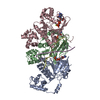
|
|---|---|
| 1 |
|
- Components
Components
| #1: Protein |  / hRAD51 / RAD51 homolog A / hRAD51 / RAD51 homolog AMass: 37008.074 Da / Num. of mol.: 3 Source method: isolated from a genetically manipulated source Source: (gene. exp.)   Homo sapiens (human) / Gene: RAD51, RAD51A, RECA Homo sapiens (human) / Gene: RAD51, RAD51A, RECAProduction host:   Escherichia coli 'BL21-Gold(DE3)pLysS AG' (bacteria) Escherichia coli 'BL21-Gold(DE3)pLysS AG' (bacteria)References: UniProt: Q06609 #2: DNA chain | | Mass: 2692.778 Da / Num. of mol.: 1 / Source method: obtained synthetically / Source: (synth.)   Homo sapiens (human) Homo sapiens (human)#3: DNA chain | | Mass: 2773.904 Da / Num. of mol.: 1 / Source method: obtained synthetically / Source: (synth.)   Homo sapiens (human) Homo sapiens (human)#4: Chemical | #5: Chemical | |
|---|
-Experimental details
-Experiment
| Experiment | Method:  ELECTRON MICROSCOPY ELECTRON MICROSCOPY |
|---|---|
| EM experiment | Aggregation state: FILAMENT / 3D reconstruction method: helical reconstruction |
- Sample preparation
Sample preparation
| Component |
| ||||||||||||||||||||||||||||||
|---|---|---|---|---|---|---|---|---|---|---|---|---|---|---|---|---|---|---|---|---|---|---|---|---|---|---|---|---|---|---|---|
| Molecular weight | Value: 24.18 kDa/nm / Experimental value: NO | ||||||||||||||||||||||||||||||
| Source (recombinant) | Organism:   human (human) / Plasmid human (human) / Plasmid : 1 : 1 | ||||||||||||||||||||||||||||||
| Buffer solution | pH: 7.5 Details: 25mM Tris-HCl, pH 7.5, 50mM KCl, 1mM dithiothreitol, 1mM AMP-PNP and 2mM MgCl2 | ||||||||||||||||||||||||||||||
| Specimen | Conc.: 0.075 mg/ml / Embedding applied: NO / Shadowing applied: NO / Staining applied : NO / Vitrification applied : NO / Vitrification applied : YES : YES | ||||||||||||||||||||||||||||||
| Specimen support | Grid material: COPPER / Grid mesh size: 300 divisions/in. / Grid type: Quantifoil R1.2/1.3 | ||||||||||||||||||||||||||||||
Vitrification | Instrument: FEI VITROBOT MARK IV / Cryogen name: ETHANE / Humidity: 100 % / Chamber temperature: 289 K |
- Electron microscopy imaging
Electron microscopy imaging
| Experimental equipment |  Model: Titan Krios / Image courtesy: FEI Company |
|---|---|
| Microscopy | Model: FEI TITAN KRIOS |
| Electron gun | Electron source : :  FIELD EMISSION GUN / Accelerating voltage: 300 kV / Illumination mode: FLOOD BEAM FIELD EMISSION GUN / Accelerating voltage: 300 kV / Illumination mode: FLOOD BEAM |
| Electron lens | Mode: BRIGHT FIELD Bright-field microscopy / Nominal defocus max: 2500 nm / Nominal defocus min: 1500 nm / Calibrated defocus min: 1500 nm / Calibrated defocus max: 2500 nm / Cs Bright-field microscopy / Nominal defocus max: 2500 nm / Nominal defocus min: 1500 nm / Calibrated defocus min: 1500 nm / Calibrated defocus max: 2500 nm / Cs : 2.7 mm / C2 aperture diameter: 70 µm : 2.7 mm / C2 aperture diameter: 70 µm |
| Image recording | Average exposure time: 8 sec. / Electron dose: 50 e/Å2 / Detector mode: SUPER-RESOLUTION / Film or detector model: GATAN K2 SUMMIT (4k x 4k) / Num. of grids imaged: 2 / Num. of real images: 528 |
| Image scans | Sampling size: 5 µm / Width: 7676 / Height: 7420 / Movie frames/image: 32 / Used frames/image: 3-14 |
- Processing
Processing
| EM software |
| |||||||||||||||||||||||||||||||||||||||||||||||||||||||||||||||||
|---|---|---|---|---|---|---|---|---|---|---|---|---|---|---|---|---|---|---|---|---|---|---|---|---|---|---|---|---|---|---|---|---|---|---|---|---|---|---|---|---|---|---|---|---|---|---|---|---|---|---|---|---|---|---|---|---|---|---|---|---|---|---|---|---|---|---|
CTF correction | Type: PHASE FLIPPING ONLY | |||||||||||||||||||||||||||||||||||||||||||||||||||||||||||||||||
| Helical symmerty | Angular rotation/subunit: 56.18 ° / Axial rise/subunit: 15.8 Å / Axial symmetry: C1 | |||||||||||||||||||||||||||||||||||||||||||||||||||||||||||||||||
| Particle selection | Num. of particles selected: 41146 | |||||||||||||||||||||||||||||||||||||||||||||||||||||||||||||||||
3D reconstruction | Resolution: 4.5 Å / Resolution method: FSC 0.143 CUT-OFF / Num. of particles: 30194 / Algorithm: BACK PROJECTION / Num. of class averages: 78 / Symmetry type: HELICAL | |||||||||||||||||||||||||||||||||||||||||||||||||||||||||||||||||
| Atomic model building | Space: REAL | |||||||||||||||||||||||||||||||||||||||||||||||||||||||||||||||||
| Atomic model building | PDB-ID: 1SZP Pdb chain-ID: E / Pdb chain residue range: 80-395 |
 Movie
Movie Controller
Controller





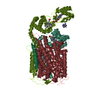

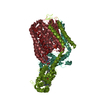
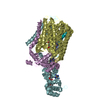
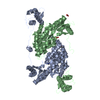
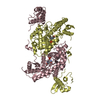

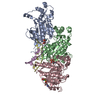
 PDBj
PDBj













